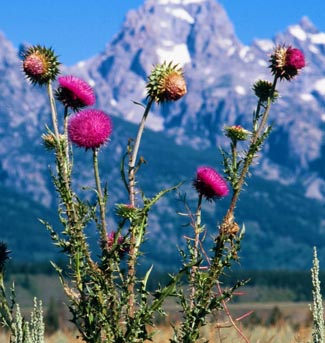Musk Thistle

Common Name(s):
Musk Thistle
Nodding Thistle
Scientific Name:
Carduus nutans L.
Scientific Name Synonyms:
None known
Symbol:
CANU4
Description:
Life Span: Biennial, Perennial
Origin: Introduced
Season: Cool
Growth Characteristics: A colony-forming weed, growing up to 6 feet tall, with a spiny stem and long fleshy taproot. Musk thistle reproduces solely by seed.
Flowers/Inflorescence: The inflorescence is terminal, solitary, 1 ½ to 3 inches in diameter, and usually bent over. They are deep rose, violet, purple, or occasionally white in color. There are broad, spine-tipped bracts found directly below the inflorescence.
Fruits/Seeds: Shiny, yellowish-brown with a plume of white hair-like fibers, 3/16 inch long.
Leaves: Dark green with a light green midrib, deeply lobed, with spiny margins.
Ecological Adaptions:
Musk thistle invades pasture, range, and forestlands. It is often found on roadsides, waste areas, ditch banks, stream banks and in grain fields. It spreads rapidly, forming extremely dense stands that crowd out desirable forages. Musk thistle is shade intolerant.
Soils: Adapted to a broad range of soils, establishment is best on bare soil. Musk thistle is tolerant of saline and acidic soils.
Associated Species: Widespread
Uses and Management:
Musk thistle is a noxious weed in Utah. Chemical control is effective. An introduced biological control agent, the musk thistle weevil, feeds on the seeds and can limit the spread of this plant. but will not eliminate it.
Musk thistle is not palatable to livestock because of its long sharp spines. Musk thistle does provide a source of nectar for high quality honey.

